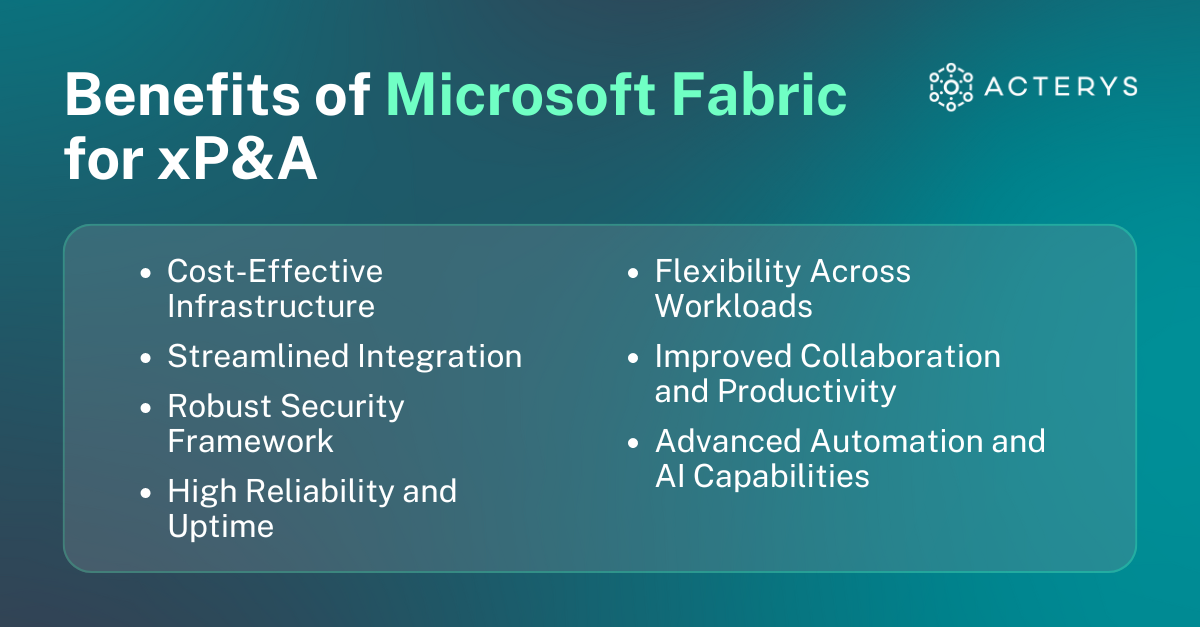
Table of Contents
Every company wants to leverage business intelligence for data-driven decisions, but they don’t always have the right tools for managing their data. Fortunately, companies in the Microsoft ecosystem have a ready-made option for data management, analytics, and business intelligence, called Microsoft Fabric. But what is this technology all about, and how does it help businesses?
Microsoft Fabric offers an end-to-end analytics platform that simplifies the integration, management, and analysis of business data. It brings together key Microsoft technologies, including Azure Data Factory and Azure Synapse’s real-time analytics. In short, Microsoft Fabric streamlines how businesses handle data across functions for better decision-making.
Learn why Microsoft Fabric is so valuable, how it informs strategic planning, business performance management and extended planning and analysis (xP&A), and how it helps users unlock previously inaccessible insights. Plus, find out how Acterys maximizes the value of Fabric and Power BI for xP&A.
Key Features of Microsoft Fabric
Microsoft Fabric is a holistic analytics solution that streamlines the entire data life cycle. The software-as-a-service (SaaS) platform combines numerous data-related functions into a single environment, which reduces the need for multiple disparate tools, simplifies IT infrastructure, and reduces overhead costs.
Here are some of the key features of Microsoft Fabric for business users:
Data Engineering
Microsoft Fabric includes powerful tools like Spark, which help data engineers handle large-scale data transformations and processing. The platform streamlines the scheduling and orchestration of complex jobs to maintain consistent and reliable data pipelines across the organization.
Data Warehousing
The platform provides SQL-based analytics known for their high performance and scalability. Microsoft Fabric optimizes resource utilization by separating compute from storage, which enhances query performance and allows for flexible resource scaling as needed without impacting data availability.
By putting Fabric data in OneLake, – a unified data lake built on Azure Data Lake Storage – you get a single, scalable repository for all of your organizational data. OneLake supports a variety of data types and structures, such as structured data housed in relational databases, unstructured data from IoT devices, or social media streams.
Data Science
Microsoft Fabric seamlessly integrates with Azure Machine Learning to support the entire machine learning lifecycle, from data preparation to model deployment. This integration includes tools for model training, management, and deployment, as well as built-in features for experiment tracking and model registry.
Real-Time Analytics
The platform can handle high-velocity data in real time, making it ideal for applications that demand immediate insights from streaming data sources. Fabric supports complex event processing and response while being able to handle any data format or source. Fabric is superior to traditional data warehousing setups in its ability to handle this data, which often isn’t fully structured.
Business Intelligence
Fabric’s integration with Power BI offers rich visualization tools and dashboards to transform data into actionable insights for business decision-makers. Power BI’s intuitive interfaces and advanced analytical capabilities help users quickly identify trends, anomalies, and opportunities.
Microsoft Fabric vs. Power BI: What’s the Difference?
Microsoft Fabric and Power BI are each designed to improve business intelligence and decision-making, and each benefit from advanced artificial intelligence (AI) and machine learning (ML) capabilities. However, while both are part of the Microsoft ecosystem and used alongside one another by countless companies, their core functionalities cater to different user needs and scenarios.
Common Ground
Power BI and Fabric are foundational components of Microsoft’s data analytics strategy along with tools such as the generative AI assistant, Copilot. Together, they streamline the process of data analysis, interpretation, and visualization, helping businesses leverage data across functional domains.
Distinctive Differences
Microsoft Fabric is great for environments where there’s a need to manage massive data transformations, leverage advanced analytics, and deploy comprehensive data governance across the enterprise. For example, many manufacturers deploy IoT devices, which generate large streams of data. Fabric can offer complex real-time analytics to optimize production processes and predictive maintenance for these industrial companies.
By contrast, Power BI is tailored for dynamic data visualization and decision support, making it ideal for departments that need quick insights without the complexity of large-scale data integration. Power BI shines in use cases like sales and marketing, where teams benefit from interactive dashboards that display real-time customer data for quick analysis and decision-making. Power BI helps these teams visualize data through intuitive interfaces.
Choosing the Right Tool
Deciding between Microsoft Fabric and Power BI depends on how your organization manages and analyzes data. Fabric is a great choice for companies that handle complex data operations involving multiple data sources and systems. It’s also suited for larger organizations that need to integrate and analyze large volumes of data across platforms. These organizations tend to require advanced analytics capabilities, such as predictive analytics and real-time data processing.
Power BI is a great choice for straightforward data visualization needs. Using Power BI for FP&A, companies can quickly turn data into insights through easy-to-understand reports and dashboards. Power BI is especially useful for teams that need to monitor key performance indicators (KPIs) and trends but don’t have deep technical expertise. Power BI’s easy-to-understand visual representations of their data help teams present information clearly and make business decisions quickly.
Because both are Microsoft tools, they’re designed to work well together. Premium customers can even use Power BI in Fabric without switching platforms.

Benefits of Microsoft Fabric for Extended Planning and Analysis
Cost-Effective Infrastructure
Microsoft Fabric’s architecture can scale up or down based on business size or resource needs, which is just one of the benefits for xP&A functions. By paying only for the resources needed, you prevent unnecessary spending on unused capacity.
Because Fabric is cloud-based, companies reduce their need for physical infrastructure and associated maintenance costs. The platform’s integrated approach to data management and analytics also reduces the need for extensive training and specialization among staff.
Streamlined Integration
Microsoft Fabric integrates with a variety of tools, including many outside the Microsoft ecosystem. As a unified platform, financial data flows smoothly across applications, reducing the complexities of dealing with disparate systems. For xP&A, this means improved data accuracy, quicker consolidation, and timely financial reporting.
Robust Security Framework
Microsoft Fabric uses Microsoft’s cloud security expertise to continuously update its defenses. The platform offers advanced identity management through Microsoft Entra ID and secured data transactions. Your data remains protected within private networks and across services like Power BI and Synapse.
Fabric’s security is always on, featuring strong encryption and flexible access controls to keep your business data secure and in compliance.
High Reliability and Uptime
Downtime can lead to missed opportunities and operational disruptions. Microsoft Fabric’s promise of 99.9% uptime means that xP&A systems are essentially always operational. This reliability ensures that financial processes remain uninterrupted and resilient to system failures.
Flexibility Across Workloads
Microsoft Fabric’s flexibility includes the ability to integrate with and process data sources regardless of origin (internal, external, or cloud storage). This allows xP&A teams to effortlessly combine historical financial data with real-time operational data.
Fabric supports a broad range of financial activities, from routine data management to advanced analytical tasks such as predictive modeling and financial forecasting. For example, the platform can automatically adjust to different financial models, enabling users to execute complex simulations with ease.
Improved Collaboration and Productivity
Fabric contributes to collaboration and productivity by integrating with other Microsoft tools, including Microsoft Teams and Power BI. This integration allows xP&A teams to conduct real-time discussions and make updates alongside their data analytics workflows.
The connection with Power BI lets teams visualize financial data within the same platform, saving time and reducing the chance of human error. Teams, meanwhile, can be valuable for coordinating efforts across departments and geographies.
Advanced Automation and AI Capabilities
Microsoft Fabric unlocks predictive analytics and trend analysis that can redefine financial forecasting and risk assessment. Microsoft Fabric’s data analytics improves xP&A operations by automating routine tasks such as data collection, data validation, and report generation. This automation liberates the xP&A team from manual processes, enabling them to dedicate more time to strategic analysis and decision-making.

How to Improve xP&A With Microsoft Fabric, Power BI and Acterys
Microsoft Fabric integrates a range of data sources into one cohesive platform. This single source of truth ensures data consistency, accuracy, and integrity. With Fabric, you lay the foundation for reliable financial analysis and decision-making.
With Power BI’s reporting tools, you can transform raw data into interactive dashboards and detailed reports. By consolidating data, organizations eliminate silos, reduce discrepancies, and ensure decision-making is based on the same reliable data. This centralized approach improves transparency and accountability within financial operations.
Acterys adds a critical layer to the xP&A process by enabling users to not only analyze data within Power BI but also input and adjust data directly from their reports and dashboards. This Power BI write-back functionality allows xP&A teams to quickly modify forecasts, adjust budgets, and test scenarios directly within their analytical tools. The combination of Microsoft Fabric, Power BI, and Acterys offers a dynamic and interactive approach to business planning. Your team can instantly see the results of their efforts and analyze them in real time.
Set Your Business Up for Success
What is Microsoft Fabric’s biggest advantage? Its ability to integrate and manage vast amounts of data from numerous sources while empowering business leaders to make informed, strategic decisions.
Microsoft Fabric provides an end-to-end analytics platform that combines critical systems to streamline data processes and improve your ability to engage in meaningful xP&A. Combine Fabric and Acterys to improve your capabilities further. Acterys provides robust xP&A solutions that allow for advanced scenario modeling and real-time financial insights. Integrating these tools helps users quickly adjust their forecasts and budgets based on timely, reliable data.
Embrace the future of business intelligence with Microsoft Fabric and Acterys. Set your business up for success by investing in a platform that grows with you and keeps you a step ahead. Ready to get started? Sign up for your free trial.



